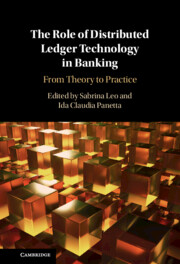Book contents
- The Role of Distributed Ledger Technology in Banking
- The Role of Distributed Ledger Technology in Banking
- Copyright page
- Dedication
- Contents
- Figures
- Tables
- Boxes
- Contributors
- Acknowledgements
- Introduction
- Part I Why Pay Attention to Distributed Ledger Technology in Banking?
- Part II Opportunities and Challenges in Crypto-Asset Regulation
- Part III The Power of Distributed Ledgers in Payments
- 6 DLT in Payments
- 7 Central Bank Digital Currency
- 8 Opportunities, Challenges, and Design of CBDCs
- 9 A Proposal for an Asia Digital Common Currency (ADCC) Applying Distributed Ledger Technology (DLT) and Blockchain Technology (BCT)
- Part IV Enabling Financial Inclusion and ESG with Distributed Ledger Technology
- Part V A Further Look at DLT in Banking: Lessons Learned, Current Applications, and Future Scenarios
- Index
8 - Opportunities, Challenges, and Design of CBDCs
The Italian Approach to a New Technology
from Part III - The Power of Distributed Ledgers in Payments
Published online by Cambridge University Press: 26 October 2023
- The Role of Distributed Ledger Technology in Banking
- The Role of Distributed Ledger Technology in Banking
- Copyright page
- Dedication
- Contents
- Figures
- Tables
- Boxes
- Contributors
- Acknowledgements
- Introduction
- Part I Why Pay Attention to Distributed Ledger Technology in Banking?
- Part II Opportunities and Challenges in Crypto-Asset Regulation
- Part III The Power of Distributed Ledgers in Payments
- 6 DLT in Payments
- 7 Central Bank Digital Currency
- 8 Opportunities, Challenges, and Design of CBDCs
- 9 A Proposal for an Asia Digital Common Currency (ADCC) Applying Distributed Ledger Technology (DLT) and Blockchain Technology (BCT)
- Part IV Enabling Financial Inclusion and ESG with Distributed Ledger Technology
- Part V A Further Look at DLT in Banking: Lessons Learned, Current Applications, and Future Scenarios
- Index
Summary
This chapter analyse if and how new technologies, and the distributed ledger technology (DLT), could really represent an opportunity, and not a threat, for the banking industry. Through the illustration of the Spunta DLT project, we illustrate how the Italian Banking Association has concretely brought the permissioned blockchain in the Italian banking sector, through an infrastructure for banks operating in Italy that in the future may host other applications. The chapter then dwells on the possibility that the ECB could issue a CBDC, and ABI’s position is presented. In this context, considering the experience gained on DLT, an experimental path related to the digital Euro is illustrated. This project was launched by ABI in December 2020 with the aim of actively contributing to the public debate and supporting Italian banks in the process of preparation for the future scenario, in the case the ECB decides to issue a digital Euro. The chapter concludes with an update on the current scenario that foresees the Eurosystem working on a possible functional design based on and prototyping the digital Euro. In the description of the current scenario, we wish to emphasise that, to effectively compete with comparable instruments offered by private entities or other foreign central banks, it is desirable that the digital Euro enable exchanges beyond the mere transfer of money. Moreover, for the digital Euro to be successful, it must enable the provision of value-added services, thereby supporting competition without displacing private initiatives, primarily around digital payments and avoiding the risk of disintermediation.
Keywords
- Type
- Chapter
- Information
- The Role of Distributed Ledger Technology in BankingFrom Theory to Practice, pp. 172 - 188Publisher: Cambridge University PressPrint publication year: 2023



